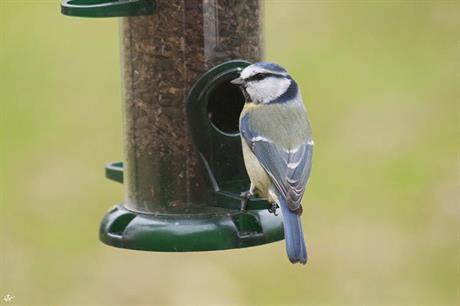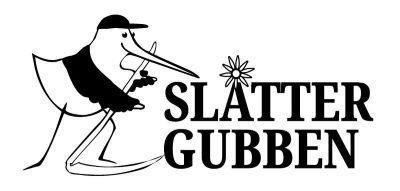Ask your question!
If you can't find the answer to your question on this page, you can send it directly to us using the form below.
Slåttergubbens Question Box
1. When should I start feeding the birds?

The earlier, the better. This way, the birds learn that there is food at your place, and the chance that they stay at your feeding station is greater. Those who want to migrate will migrate. The instinct is so strong that there is no risk of "tricking" a bird into staying by feeding it.
Personally, I usually start around October 15th and have done so for several years. I know when it's time—greenfinches and house sparrows fly anxiously around the feeding spot and wait for me to get started.
2. ... and when should I stop?

Stop When You Want! Many people feed birds all year round and enjoy the different species that appear depending on the season.
Birds do not stop searching for their own food. It is an inherited behavior that occurs regardless of whether they occasionally get a sunflower seed.
Keep in mind that diseases spread more easily during the warm summer months. Be more diligent in cleaning up around your feeding area and clearing away any shells and old seeds that have been lying around for too long. Swallows, swifts, and warblers that are with us during the summer don't even glance at the finest bird seeds - they are insectivores. The most important thing you can do for the birds during the summer months is to create more diversity in the garden, which generates an abundance of insects - the natural bird food. In addition to benefiting all bird species, hundreds of species of insects, plants, fungi, etc., will also thrive.
Here on our website, you’ll find many tips on how to create meadows and make your garden more inviting for all birds!
3. I want to keep magpies and crows away from the food. How do I do that?

Unfortunately, the larger birds tend to scare away the smaller ones, which is probably why magpies, jackdaws, and crows are not particularly popular at bird feeders. For the sake of the small birds, however, this is a minor issue. The larger birds are not there all the time, even if it might feel that way.
But there are solutions for those who want them. Perhaps the easiest is the popular Ferris wheel that we sell. It begins to spin even when a small blue tit sits on a bucket. In our webshop, there are also cages available that are suitable for covering some smaller tube feeders.
Compost nets are popular for building cages or to completely enclose your feeder if you really want to keep large birds away. However, keep in mind that larger woodpeckers, partridges, and pheasants may also be excluded.
4. Why is organic bird food better than conventional?

A short answer is impossible to this question, but feel free to read what we write about organic farming here.
Many people believe that sprayed seeds are more harmful for the birds that eat them. This myth would be easy for us to continue if we wanted to sell organic bird food.
But it's not true; the residue from pesticides in seeds and grains is extremely small. (In grapes and some fruits, however, there can be quite a cocktail of chemicals at reasonably high doses). Moreover, these doses are more dangerous for us who live longer and accumulate more toxins in our bodies.
No, we don't buy organic primarily because it's healthier food for the birds. We buy it because it results in more flowers, insects, and birds in and around the fields where the food is grown. This benefits many bird species that are much more threatened than those that come to eat bird food in the winter. Lapwing, skylark, barn swallow, wheatear, partridge, corncrake, swift, and yellow wagtail are examples of birds that benefit from organic farming.
Organic bird food = unsprayed = more insects = better conditions for birds.
5. Can rats and mice come?

It would be good to revise the perception of mice and rats. Inside houses, they are naturally not welcome, but what's so terrible about having them outside? There, they are part of the ecosystem; if we disadvantage them, we also disadvantage those who eat them. Just ask the barn owl what it thinks! It is almost extinct in Sweden, mostly because small rodents do not thrive in the new agricultural landscape.
We would gratefully welcome concrete evidence of what makes a rat or mouse so much more unhygienic compared to any of our pets. In fact, our migrating birds should be a far greater source of infection than mice and rats. Imagine a newly arrived Pied flycatcher in the spring with its cheerful lively song. We've longed for it and cherish it! What we don't consider is that it might have been sitting next to an open sewage ditch, catching insects and drinking from the water just a week ago. Perhaps there was an Ebola outbreak right there and then? Maybe it's outside the birdhouses where the Pied flycatcher will build its nest that we should be setting mouse traps? If it's hygiene and infections we cite as excuses to kill rodents. Just kidding, of course—I advise no one to kill flycatchers. But it's an intriguing thought—who is really more unhygienic?
Rodents have always destroyed our stored food and gnawed through various things, so it's probably easy to blame diseases and other nuisances on them.
6. Some birds look sick and weak. Why is that?

Swedish winters can be tough, especially towards the end of winter, if February and March become particularly cold. It is not uncommon for birds like greenfinches, siskins, and redpolls to succumb to harsh conditions. Drooping wings and "fluffing up" are signs of illness or weakness. Unfortunately, there is not much to be done in such cases other than letting nature take its course.
To prevent the spread of contagious diseases at bird feeders, we recommend the following:
- Move the feeders a few times during the season (or as often as you can) - the birds that feed on the ground will then move to new, clean locations.
- Use multiple feeders
- Consider feeding on the ground where no seeds are falling from feeders - but over large areas so that the birds are spread out. Field seeds and our Lantliv mix are best. You can also relocate the ground feeding areas a bit.
- Feed only during the cold season (reduces disease spread)
7. Why are there no birds at my place?
 Ser ni katten?
Ser ni katten?
A difficult question we often get. But here are some reasons:
* The feeder is too close to the house. This makes birds feel unsafe and they might not dare to approach.
* Lack of shelter for the birds. Bushes, trees, and hedges are essential for quickly taking cover from dangers that small birds face. It could be a sparrowhawk hunting, a nearby cat, or you and I disturbing them unknowingly. Try to place your feeder near a dense bush, which birds prefer.
* Competition from neighbors. Bird feeding is popular. If you have one or more neighbors offering a variety of food types and who started early in the season, it might be challenging to attract birds to your place. Try to vary what you offer, feeding with sunflower seeds, millet, suet, and nuts.
* A hungry cat. Having a hunting-keen cat can be troublesome. Birds won't dare to come down to the feeder if the cat is constantly waiting.
